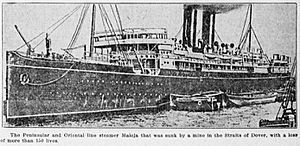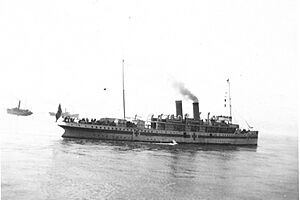SS Maloja facts for kids

Peninsula and Oriental line steamer Maloja
|
|
Quick facts for kids History |
|
|---|---|
| Name | SS Maloja |
| Owner | P&O Steam Navigation Co |
| Port of registry | |
| Route | Tilbury – Bombay |
| Builder | Harland and Wolff Ltd, Belfast |
| Yard number | 414 |
| Launched | 17 December 1910 |
| Completed | 7 September 1911 |
| Fate | Mined off Dover, 27 February 1916 |
| General characteristics | |
| Class and type | P&O M-class passenger liner |
| Tonnage | 12,431 GRT |
| Length | 550.4 ft (167.8 m) |
| Beam | 62.9 ft (19.2 m) |
| Depth | 34.4 ft (10.5 m) |
| Installed power | 1,164 NHP |
| Propulsion |
|
| Speed | 19 knots (35 km/h) |
| Capacity | 670 passengers |
| Crew | 301 (British officers & Lascar crew) |
| Armament | Defensively Equipped Merchant Ship |
The SS Maloja was a large passenger ship built for the Peninsular and Oriental Steam Navigation Company, also known as P&O. She was finished in 1911 and sailed regularly between Great Britain and India. In 1916, during the First World War, the Maloja sank after hitting a mine in the English Channel near Dover. Sadly, 155 people lost their lives.
Contents
Building the Maloja
The Maloja was one of P&O's "M-class" passenger ships. The first ship in this class was the RMS Moldavia, built in 1903. The famous shipbuilders Harland and Wolff Ltd built the Maloja in Belfast, finishing her in 1911.
The ship had two propellers that helped her move through the water. These propellers were powered by two large steam engines. The Maloja could travel at a speed of about 19 knots (35 km/h or 22 mph). She was designed to carry many people, with space for 670 passengers, along with cargo.
The Sinking of the Maloja
On Saturday, February 26, 1916, at 3:00 PM, the Maloja left Tilbury, England. She was heading to Bombay (now Mumbai) in India. On board were 122 passengers, including soldiers, government workers, and families with children. The ship also carried a variety of goods. Her crew of 301 included British officers and Lascar (South Asian) sailors.
The next morning, Sunday, February 27, the Maloja was approaching the Strait of Dover. She was moving quickly and passed another ship, a Canadian coal carrier called Empress of Fort William. Because it was wartime, all ships had to be checked by a patrol boat before they could continue their journey.
A German submarine, SM UC-6, had recently placed mines in the strait. Around 10:30 AM, when the Maloja was about 2 nautical miles (3.7 km) off Dover, her right side hit one of these mines. There was a huge explosion. The force of the blast damaged parts of the ship. The Empress of Fort William was still nearby and immediately sped up to help. However, while still about 1 nautical mile (1.9 km) away, the coal carrier also hit one of the mines and began to sink.
To be ready for enemy attacks, the Maloja's lifeboats were already swung out, ready to be lowered quickly. The ship's captain, C.D. Irving, immediately stopped the engines. He then put them in reverse to try and stop the ship completely so the lifeboats could be launched. The ship's whistle also blew, signaling everyone to get ready to leave the ship.
Captain Irving tried to order the engines to stop again for evacuation. But water was flooding the engine room, so the engines could not be stopped. The ship continued to move backward at about 8 to 9 knots (15 to 17 km/h). The Maloja also began to tilt heavily to her right side. Passengers tried to get into the lifeboats on the right side, but because the ship was moving and tilting so much, only a few boats could be launched.
Many smaller boats rushed to help. These included Port of Dover tugs like the Lady Brassey and Lady Crundall, along with fishing trawlers, dredgers, and a destroyer. Since the Maloja was still moving backward and couldn't stop, the rescue boats found it hard to get close enough to pick up survivors. The sea was also very rough. Hundreds of people on the ship's decks could only put on lifejackets, jump into the water, and try to swim away. Some of the ship's rafts either launched or floated free, and some survivors managed to get onto them. The Maloja sank 24 minutes after hitting the mine. The Empress of Fort William sank about 40 minutes after hitting her mine.
Many people died from hypothermia (getting too cold), either in the water or after being rescued. Most of the people who survived were pulled from the water. Several survivors, including Captain Irving, were in the cold water for half an hour. The ship's Second Officer, Lieutenant C Vincent, was in the water for an hour but survived. The small rescue vessels took many survivors to hospital ships like the Dieppe and St David. Others were brought ashore, and Royal Navy ambulances took them to the Lord Warden Hotel. Survivors were later taken by a special train to London Victoria.
Around 11:30 AM, boats began bringing bodies ashore. The police chief of Kent took charge of the deceased. The Market Hall below Dover Museum was used as a temporary place to identify the bodies. 45 bodies were found, but about 100 more people were never found.
Memorials for the Lost
Thirteen of the people who died are buried in the St Mary the Virgin New Cemetery in Dover. These include three servicemen, four women, and four children aged 3, 5, 6, and 8.
The servicemen were given special graves by the Commonwealth War Graves Commission. Besides the three buried in Dover, one is buried in Horsham and another in Portsmouth.
Many of the 155 people who died were Lascar sailors. P&O built a monument in St Mary's Cemetery to honor 22 of them.
A New Maloja
In 1923, P&O replaced the lost ship with a new, larger vessel also named RMS Maloja. This second Maloja survived the Second World War and was taken apart for scrap metal in 1954.
The Wreck Today
The wreck of the original Maloja lies in 80 to 100 feet (24 to 30 meters) of water. It was once a danger to other ships, so in 1964, it was blown up. This made the wreck spread out and flatten. However, enough of it remains to be a popular spot for wreck diving when the water is clear enough to see.



